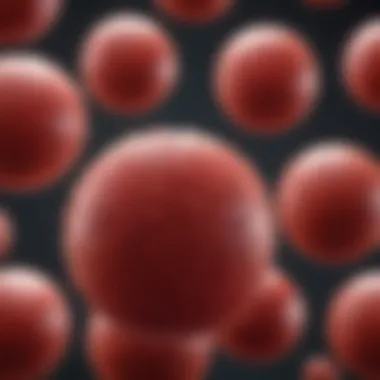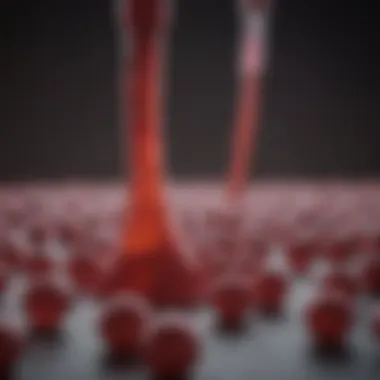Understanding Red Cell Distribution Width in Hematology


Intro
Red Cell Distribution Width (RDW) is an important hematological parameter that measures the variation in the size of red blood cells (RBCs). This metric offers valuable insights into a range of health conditions. Understanding RDW is essential for healthcare professionals, researchers, and students who aim to interpret blood test results effectively. As an indicator of anisocytosis, RDW provides a window into not only the presence of anemia but also other related disorders.
A thorough grasp of RDW can lead to better clinical outcomes. By exploring RDW in conjunction with other metrics, clinicians can enhance diagnostic accuracy. This narrows down the possible health issues affecting the patient.
In the following sections, we will delve into the methodological approaches of RDW measurement, its clinical significance, and current trends in the science surrounding this critical blood test.
Research Overview
Methodological Approaches
Measuring RDW typically involves automated hematology analyzers. These machines provide precise readings by assessing the size of the RBCs during blood sample analysis. In this process, the coefficient of variation of RBC volume is calculated, resulting in the RDW value.
Two primary methods exist for evaluating RDW: the traditional blood smear and modern technology like impedance-based analyzers. While blood smears require manual assessment, impedance-based methods offer rapid and reproducible results. Current guidelines suggest that RDW should be considered alongside other parameters like Mean Corpuscular Volume (MCV) for a comprehensive picture of hematological health.
Significance and Implications
The clinical implications of RDW are vast. A high RDW value is often associated with various types of anemia, including iron deficiency anemia and chronic disease anemia. Furthermore, elevated RDW readings have been linked to cardiovascular disease, certain cancers, and even inflammatory states such as rheumatoid arthritis.
RDW is also gaining interest as a prognostic factor in acute illnesses. Recent studies indicate that RDW may predict outcomes in patients with cardiovascular conditions and respiratory diseases. Thus, understanding RDW can pave the way to improved patient stratification and treatment.
"RDW serves as a crucial indicator in detecting and managing various health conditions, expanding its role beyond traditional hematological assessments."
Current Trends in Science
Innovative Techniques and Tools
Recent advancements in blood analysis have introduced more sophisticated methods for measuring RDW. Machine learning and artificial intelligence are now being employed to enhance the accuracy of hematological evaluations, allowing for real-time data processing. Device manufacturers are focused on integrating RDW measurements into routine panels, emphasizing its growing importance in diagnostics.
Interdisciplinary Connections
RDW is not solely confined to hematology; its relevance has extended into other fields such as cardiology and oncology. Researchers are investigating the correlations between RDW and various medical conditions. This interdisciplinary approach has sparked interest in leveraging RDW as a general health marker, enhancing its diagnostic capabilities across multiple specialties.
As RDW continues to be analyzed and understood, it is evident that its role in patient care will expand further. Emphasizing on this variable during blood tests may contribute to the overall quality of healthcare provided to patients.
Prelude to Red Cell Distribution Width
Red Cell Distribution Width (RDW) is not merely a number on a blood test report; it is a significant indicator of health and disease state. Understanding RDW can aid in diagnosing various conditions, particularly those related to red blood cells. A deeper grasp of RDW provides essential insights into the variability in red blood cell size. This variability may reflect underlying issues, such as anemia or other hematological disorders. Clinicians often assess RDW alongside other parameters, emphasizing its intrinsic value in a complete blood analysis.
Definition of RDW
Red Cell Distribution Width is defined as a measurement that reflects the variation in the size of red blood cells. It is typically expressed as a percentage. An elevated RDW indicates a greater variability in red blood cell dimensions, while a lower RDW suggests more uniformity in size. Medical professionals often derive RDW during routine complete blood count (CBC) tests, where it serves as a supplementary diagnostic tool to evaluate a patient's hematological health.
Historical Context
The measurement of RDW has evolved since its inception. Initially, RDW was not included in routine hematological evaluations. However, with advances in technology and understanding of blood disorders, the importance of RDW came into spotlight in the late 20th century. Studies began to associate high RDW values with various conditions, including iron deficiency anemia and chronic inflammatory diseases. Over time, RDW has emerged as a valuable clinical parameter, informing healthcare decisions and enhancing patient assessment.
Physiology of Red Blood Cells
Understanding the physiology of red blood cells is crucial for comprehending the role of Red Cell Distribution Width (RDW) in clinical diagnostics. Red blood cells (RBCs) are fundamental components of the blood, responsible for transporting oxygen from the lungs to the body tissues and returning carbon dioxide for exhalation. A thorough grasp of their structure and function, as well as their production and lifespan, provides insight into various hematological disorders and helps clarify how RDW fits into the broader picture of blood health.


Structure and Function
Red blood cells are unique in their structure. They have a biconcave shape, which maximizes surface area for gas exchange. This design allows RBCs to deform as they travel through narrow capillaries. The primary function of these cells is to carry oxygen bound to hemoglobin, an iron-containing protein. Hemoglobin not only binds oxygen but also aids in the transportation of carbon dioxide. The effectiveness of RBCs in performing their duties relies significantly on their integrity and uniformity in size.
Here are key aspects of their structure and function:
- Biconcave Shape: Enhances surface area for oxygen uptake.
- Flexible Membrane: Allows RBCs to navigate through small vessels.
- Hemoglobin Molecules: Essential for gas transport.
- Lack of Nucleus: Gives more space for hemoglobin, optimizing oxygen binding but limits protein synthesis and repair.
These characteristics clarify why variations in RBC size, indicated by RDW, can signal underlying health conditions. A high RDW suggests greater variability in cell sizes, which may indicate different types of anemias or other disorders.
Production and Lifespan
The production of red blood cells occurs in the bone marrow, a process known as erythropoiesis. This process is tightly regulated by erythropoietin, a hormone produced by the kidneys in response to low oxygen levels in the blood. The average lifespan of an RBC is around 120 days, after which they are primarily removed by the spleen and liver.
Key points regarding RBC production and lifespan include:
- Erythropoiesis: Involves several stages, from progenitor cells to mature RBCs.
- Hormonal Regulation: Erythropoietin controls RBC production based on oxygen demand.
- Aging and Removal: Older RBCs lose their flexibility and functionality, leading to their destruction by macrophages.
Understanding the lifespan and turnover of RBCs is relevant for interpreting RDW values. An elevated RDW may correlate with the presence of newly released or distressed RBCs, which are characteristically different in size. This variability can point to metabolic or hematological issues requiring clinical attention.
Technical Aspects of RDW Measurement
Red Cell Distribution Width (RDW) is a significant parameter in blood tests. Understanding the technical aspects of RDW measurement enhances its clinical implications. This section clarifies the laboratory techniques used to calculate RDW and provides insight into interpreting RDW results.
Laboratory Techniques
The measurement of RDW primarily relies on automated hematology analyzers. These devices assess the size and volume of red blood cells. They utilize light scattering or impedance methods to obtain precise data.
- Light Scattering: This technique detects how light interacts with red blood cells. Larger cells scatter light differently than smaller ones. The analyzer captures this variance and computes the RDW.
- Impedance Method: This involves passing blood cells through an electrical field. The change in resistance as each cell flows through provides data about its size. The analyzer again calculates RDW based on these measurements.
Both methods yield results that are comparable, but there may be small discrepancies based on the technology used. Calibration and quality control are essential to ensure accuracy. As technology progresses, the ability to measure RDW becomes more refined, potentially revealing further complexities in red blood cell populations.
Interpreting RDW Results
Understanding RDW results requires contextual knowledge. The RDW value is expressed as a percentage, quantifying the variability in red blood cell sizes. Generally, a normal RDW range is between 11.5% and 14.5%. Elevated RDW may indicate certain medical conditions.
- Anemia: A high RDW can signal different types of anemia. For instance, it may point to iron deficiency anemia, where the body produces various red blood cell sizes due to a lack of iron.
- Chronic Disease: Increased RDW has associations with chronic diseases like kidney disease or inflammatory conditions. In such cases, the body responds to ongoing issues by altering red blood cell production.
- Inflammation: RDW may also correlate with levels of inflammation in the body. Elevated RDW can act as a marker for inflammation, often detected in conditions like rheumatoid arthritis.
Interpreting RDW alongside other parameters, such as Mean Corpuscular Volume (MCV), enriches its clinical value. Together, these metrics provide a more comprehensive picture of patients’ health.
"An understanding of the technical aspects of RDW provides an important basis for interpreting its clinical significance."
The integration of advanced laboratory techniques and informed interpretation of results will continue to enhance the utility of RDW in clinical practice.
Clinical Significance of RDW
Red Cell Distribution Width (RDW) serves as an essential parameter in hematology, with implications that extend far beyond mere statistical data. Understanding its clinical significance can revolutionize how healthcare professionals approach diagnosis and treatment. RDW reflects the variability in red blood cell sizes within a blood sample, providing vital clues to underlying health issues. This measurement can aid in the identification of conditions such as anemia and various chronic diseases. By focusing on RDW, practitioners can enhance patient care and optimize outcomes through early detection and intervention.
RDW and Anemia
Anemia is one of the most prevalent blood disorders globally, and understanding RDW's role in this context is crucial. RDW measurements can help distinguish between types of anemia by indicating whether red blood cells are uniformly sized or vary significantly in diameter.


- Microcytic Anemia: In cases of iron deficiency anemia, RDW is usually increased alongside a reduced mean corpuscular volume (MCV). This suggests a high degree of variability in cell size as the body attempts to produce more red blood cells.
- Macrocytic Anemia: Conversely, in macrocytic anemia, RDW may also be elevated due to the presence of larger, dysfunctional red blood cells.
"A high RDW can be a strong indicator of various types of anemia, enabling timely and targeted treatment."
By using RDW in conjunction with other metrics, clinicians can develop more precise diagnostic strategies, leading to better management of anemia-related conditions.
Role in Chronic Diseases
RDW has gained recognition as a valuable biomarker in understanding chronic diseases. Conditions such as heart disease, diabetes, and kidney disorders often coincide with changes in RDW levels. In these scenarios, elevated RDW may indicate an inflammatory state or oxidative stress, which can significantly impact patient health and its management.
- CVD Risk: Research indicates that patients with cardiovascular diseases often present with increased RDW levels. This association highlights the need for monitoring RDW in patients with known heart conditions, as it may reflect the severity or progression of the disease.
- Diabetes Mellitus: In patients with diabetes, a raised RDW can serve as an indicator of poor glycemic control or the presence of complications related to the disease.
The integration of RDW analysis into routine evaluations of patients with chronic diseases can help healthcare professionals adapt their treatment modalities more effectively.
Correlations with Inflammation
The relationship between RDW and inflammation has become a focal point for researchers. Inflammatory conditions often trigger changes in red cell production, affecting RDW metrics significantly.
- Markers of Inflammation: Elevated RDW is frequently observed in conditions like rheumatoid arthritis and inflammatory bowel disease. Increased RDW may reflect the body’s attempt to adjust red blood cell production in response to an inflammatory state.
- Cardiovascular Inflammation: In cardiovascular patients, increased RDW levels have been linked with systemic inflammation, making it a useful adjunctive marker to guide treatment decisions.
Understanding these correlations emphasizes the importance of RDW in assessing inflammatory diseases, potentially leading to improved strategies for monitoring and managing these conditions.
In summary, the clinical significance of RDW is multilayered. It offers insights into anemia, reveals the status of chronic diseases, and serves as an important indicator for inflammation. By acknowledging these relationships, healthcare professionals can elevate patient care standards, leading to more effective treatment protocols and improved outcomes.
RDW in the Context of Other Blood Metrics
The evaluation of Red Cell Distribution Width (RDW) cannot be isolated from the broader framework of hematological assessments. Understanding RDW within the context of other blood metrics enhances its utility in clinical practice. Physicians often combine multiple parameters to interpret results accurately, leading to precise diagnoses and better patient management. This nuanced understanding is essential for identifying various health conditions, particularly those involving red blood cells.
One primary consideration is the relationship between RDW and Mean Corpuscular Volume (MCV). MCV reflects the average size of red blood cells, while RDW indicates the variability in red blood cell size. A high RDW in combination with a low MCV often suggests microcytic anemia, which is a critical indicator for conditions like iron deficiency. This interplay can refine differential diagnoses and lead to targeted treatment strategies.
RDW and Mean Corpuscular Volume ()
RDW and MCV provide complementary information. While MCV helps ascertain the average volume of red blood cells, RDW reveals the diversity in their sizes. An increased RDW can signal abnormalities in red blood cell formation. For instance, in anemia, variations in size are significant as they indicate underlying pathology.
When RDW is elevated and MCV is low, it typically indicates a problem like iron deficiency anemia. Conversely, if both RDW and MCV are elevated, one might consider conditions such as macrocytic anemia. Further exploration of these connections can assist health professionals in navigating complex cases.
Integrating RDW with Complete Blood Count (CBC)
The Complete Blood Count (CBC) is a cornerstone in evaluating hematologic health. Integrating RDW within CBC parameters provides a more intricate portrait of blood health. A CBC encompasses not only RDW and MCV but also hemoglobin and hematocrit levels, among other essential metrics.
The information gleaned from this combination is invaluable. For example, low hemoglobin levels alongside high RDW can suggest a need for further investigation into potential causes of anemia. Moreover, RDW's utility in detecting inflammatory states cannot be overstated. When considering the relationship between RDW and inflammatory markers, it becomes clear that monitoring RDW can provide insights beyond traditional anemia evaluations.
In summary, assessing RDW alongside other blood metrics like MCV and within the broader CBC context significantly enhances diagnostic accuracy. This multi-faceted approach aids in the identification of underlying conditions, ensuring a more comprehensive understanding of the patient's blood health.
Impact of Lifestyle Factors on RDW
The influence of lifestyle factors on Red Cell Distribution Width (RDW) deserves thorough examination. RDW can reflect systemic changes in the body often linked to diet, physical activity, and other lifestyle elements. These factors can, in turn, shed light on underlying health issues or contribute to variations in RDW values. Understanding how these elements interact with RDW can enhance diagnostic processes and treatment strategies.
Dietary Influences
Nutrition plays a pivotal role in the health of red blood cells and, consequently, in RDW levels. A diet deficient in key vitamins and minerals can lead to significant variations in RDW.


- Vitamin B12: This vitamin is essential for proper red blood cell formation. A deficiency can cause macrocytic anemia, which can elevate RDW values. Red blood cells become larger when there is an insufficiency of Vitamin B12.
- Folate: Like Vitamin B12, folate helps in DNA synthesis and red blood cell formation. Insufficient folate intake can also result in increased RDW levels. Foods like leafy greens and legumes are good folate sources.
- Iron: Iron deficiency affects hemoglobin production and can lead to anemia. The resultant changes in red blood cell size may lead to higher RDW numbers. Iron-rich foods include red meat and fortified cereals.
- Antioxidants: Diets rich in antioxidants may stabilize cell membranes, reducing oxidative stress on red blood cells and possibly affecting RDW. Fruits, vegetables, and certain spices are rich in antioxidants.
Research suggests that maintaining a balanced diet can have a significant impact on the maintenance of optimal RDW levels. Adjusting dietary intake can assist those looking to manage or understand their RDW values better.
Physical Activity and RDW
Physical activity is another crucial lifestyle factor that affects RDW. Regular exercise influences cardiovascular health and overall blood profile, including RDW.
- Cardiovascular Health: Engaging in regular aerobic activity can improve blood flow and oxygen delivery to tissues. This, in turn, could foster a healthier red blood cell pool, possibly stabilizing RDW levels over time.
- Weight Management: Physical activity assists in maintaining a healthy weight, which can be pivotal when considering RDW. Obesity is often linked to inflammation and may influence RDW readings negatively.
- Increased Oxygen Demand: Exercise requires efficient oxygen transport. This can lead to adaptations in red blood cells, enhancing their functionality and potentially influencing RDW levels.
- Inflammatory Response: Regular physical activity can mitigate chronic inflammation, which has been associated with changes in red cell morphology. Lower inflammation can contribute to normalized RDW values.
Overall, engaging in consistent physical activity can yield positive effects on RDW. Individuals looking to adjust their RDW readings may consider incorporating more exercise into their routines.
This emphasizes the connection between lifestyle and hematological profiles, crucial for understanding RDW variations.
RDW in Different Demographic Groups
The study of Red Cell Distribution Width (RDW) in different demographic groups yields valuable insights into its clinical implications. RDW can vary across populations due to several factors. Changes in RDW can offer clues about underlying health issues and biological mechanisms unique to certain demographics.
Age-Related RDW Variability
Age impacts RDW significantly. Research indicates that RDW values tend to increase with age. This trend may be linked to various physiological changes, including alterations in hematopoiesis and increased prevalence of chronic conditions such as diabetes and cardiovascular diseases.
- Older adults often exhibit a higher RDW, potentially indicating reduced red blood cell regeneration and a lower erythropoietin response.
- There is also a correlation between elevated RDW in older populations and complications in diseases like heart failure and anemia.
- Younger individuals, including children, usually display lower RDW values. This is likely associated with their dynamic growth and healthier regenerative processes.
Gender Differences in RDW
Gender may also play a role in RDW variability. Studies have shown that men typically have higher RDW levels than women. Some possible explanations include:
- Hormonal influences: Testosterone may have a role in influencing red blood cell production, affecting RDW.
- Menstruation and iron levels: Women of reproductive age might have lower RDW values due to blood loss during menstruation, which could influence red blood cell production.
- Health conditions: Chronic diseases can present differently in men and women. For example, men might develop certain conditions that elevate RDW at a higher rate than women.
Understanding these demographic variations in RDW is essential for accurate diagnosis and treatment. Recognizing that RDW does not exist in a vacuum but is influenced by age, gender, and health status will enhance the relevance of this biomarker in clinical practice.
"Interpreting RDW in the context of demographic factors can improve the accuracy of diagnoses and the effectiveness of treatment strategies."
This connectivity emphasizes the importance of tailoring health assessments based on demographic variables, ensuring clinicians can make well-informed decisions.
Future Directions in RDW Research
Research on Red Cell Distribution Width continues to evolve. Understanding RDW is crucial for advancing our knowledge of hematology and its implications for health. Emerging studies are shifting the focus from mere measurement to understanding underlying mechanisms. Findings have shown that RDW can relate to various health conditions and outcomes, making it a valuable biomarker. This section looks at the emerging studies and innovations in diagnostics that shape future research on RDW.
Emerging Studies
Emerging research highlights the potential of RDW beyond traditional uses. Recent studies suggest that RDW may be linked to cardiovascular diseases and other inflammatory conditions. For example, some researchers found statistically significant correlations between high RDW and poor outcomes in patients with heart failure. This may indicate that RDW could serve as a prognostic indicator.
Moreover, studies are examining how RDW interacts with other parameters in blood tests. This can enhance diagnostic accuracy. The exploration of RDW in diverse populations is also necessary. Differences in RDW across demographics could reveal valuable insights into health disparities.
In addition, ongoing research is looking at genetic factors that may influence RDW values. Understanding these connections may lead to personalized medicine approaches, potentially improving outcomes for patients.
Innovations in Diagnostics
Innovations in diagnostic technology present new opportunities to measure RDW more effectively and accurately. Advancements in automated hematology analyzers improve precision and efficiency of RDW measurements. These machines are capable of analyzing large sample volumes, leading to quick turnaround times in clinical settings.
Furthermore, integrated software that combines RDW with other hematological parameters allows for more comprehensive analyses. This creates a more holistic view of a patient’s health status. For instance, artificial intelligence applications are being explored to interpret complex data sets, enhancing decision-making in clinical environments.
Finally, wearable devices that monitor various health metrics, including those relating to red blood cells, could open new avenues for monitoring RDW in real-time. Such developments are exciting and could transform the management of chronic diseases as healthcare evolves toward proactive rather than reactive care.
Understanding the future directions in RDW research is crucial for harnessing its full potential in clinical practice. As we uncover new correlations and improve methods of measurement, RDW may change how healthcare professionals approach diagnostics and treatment.



